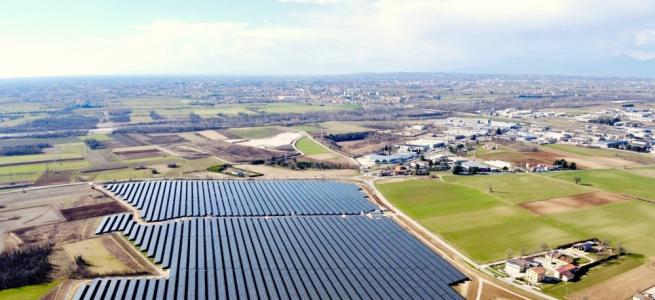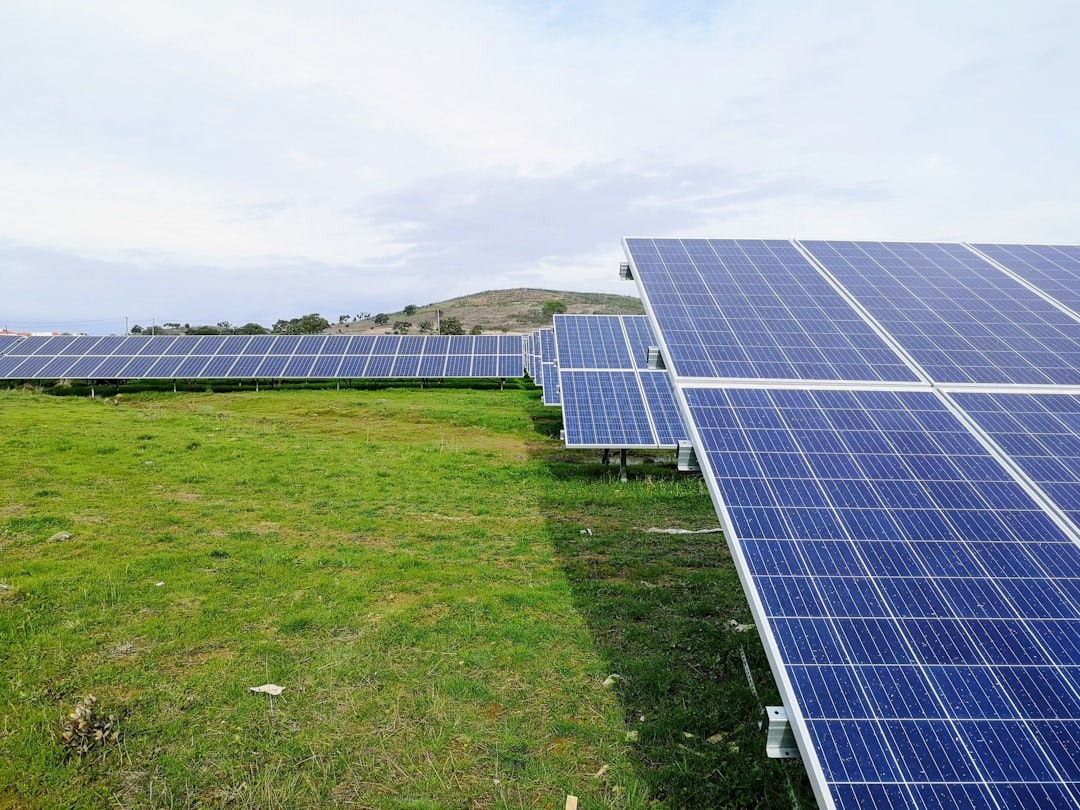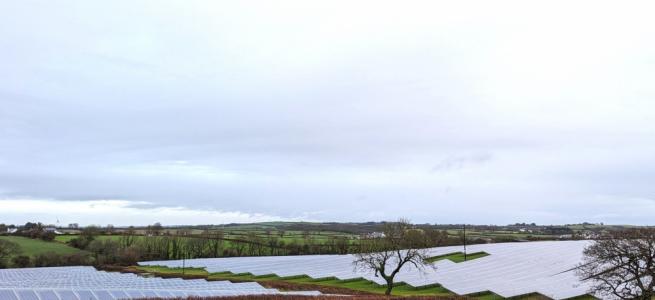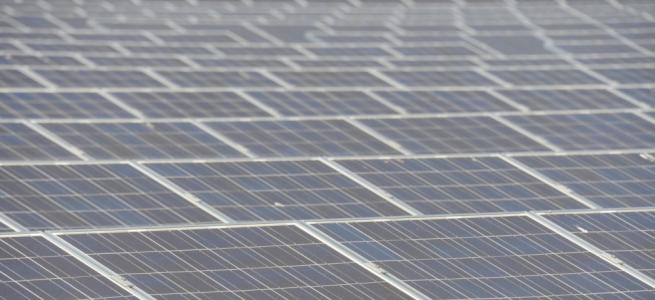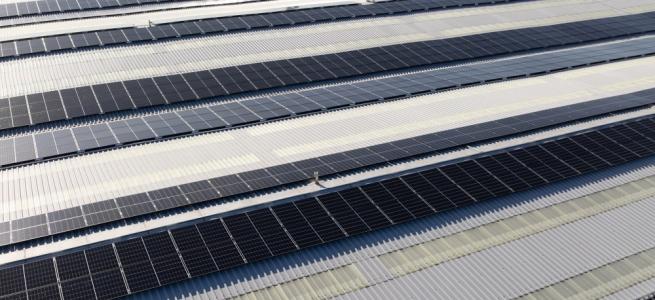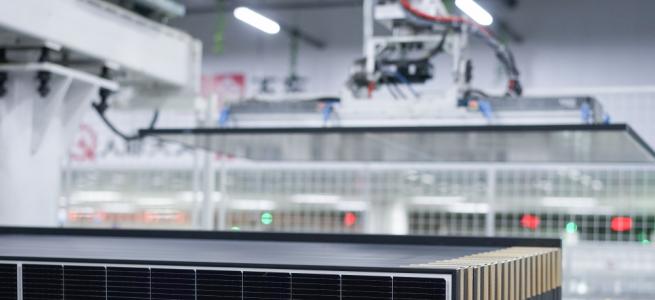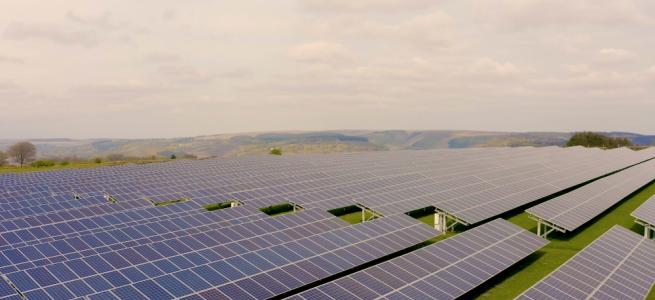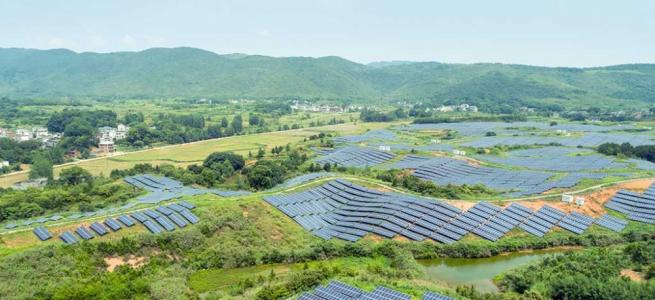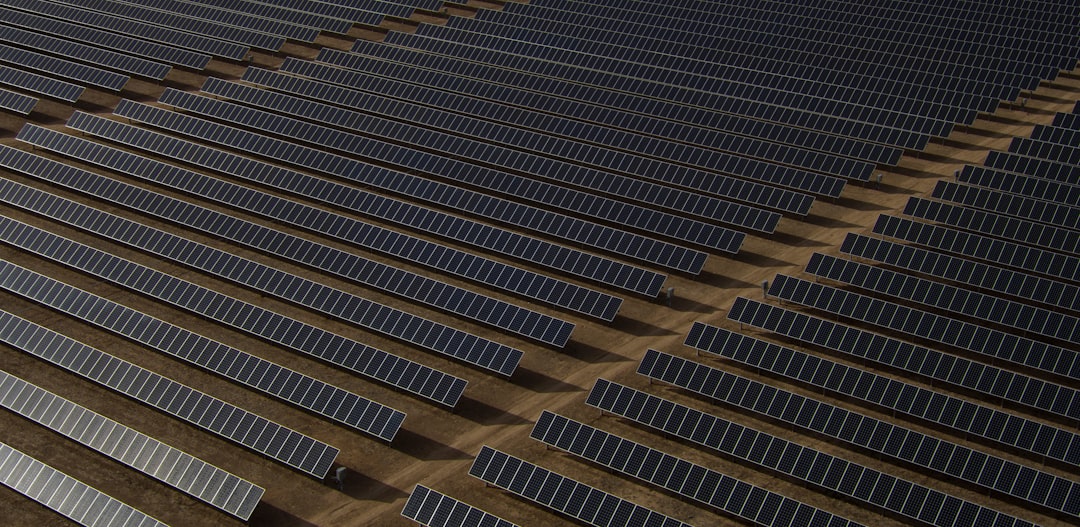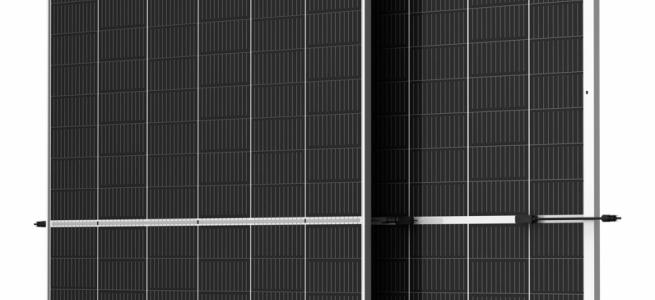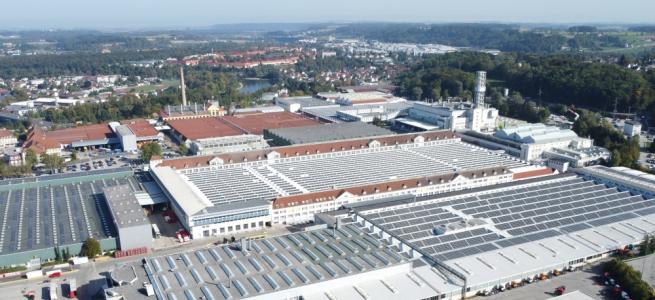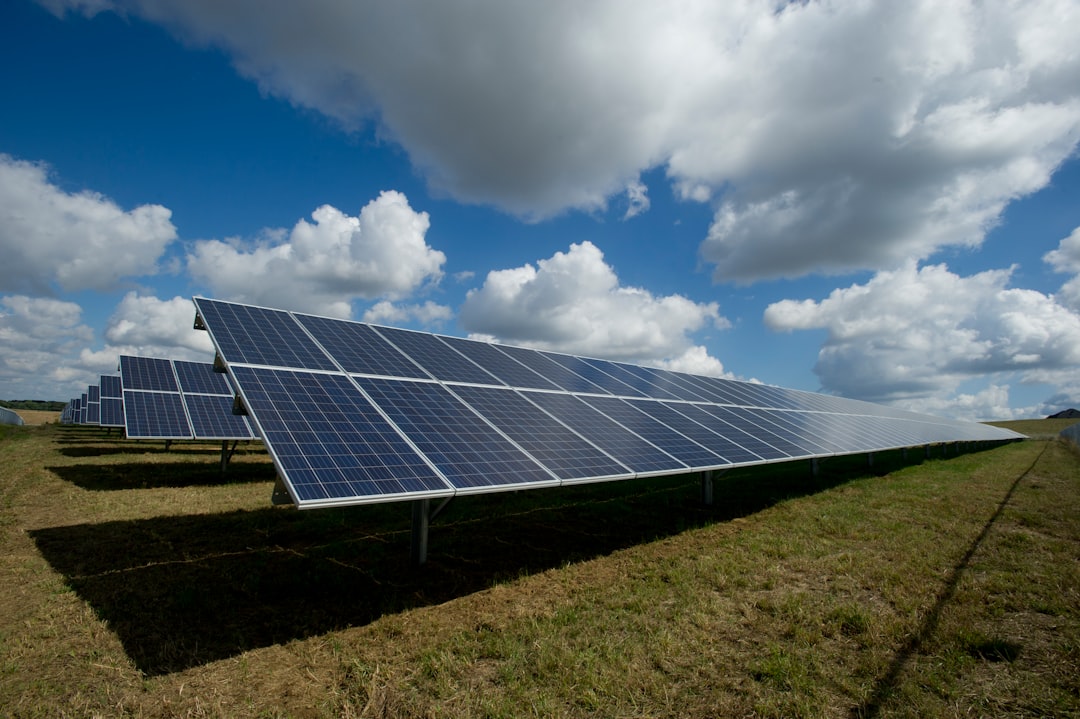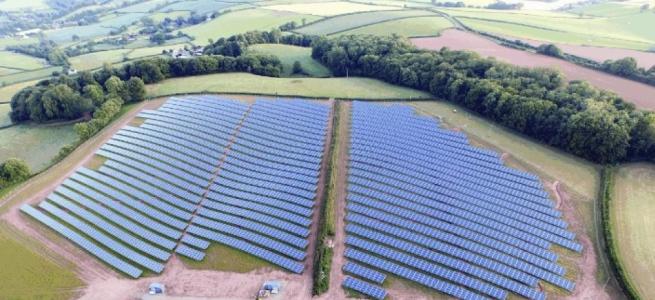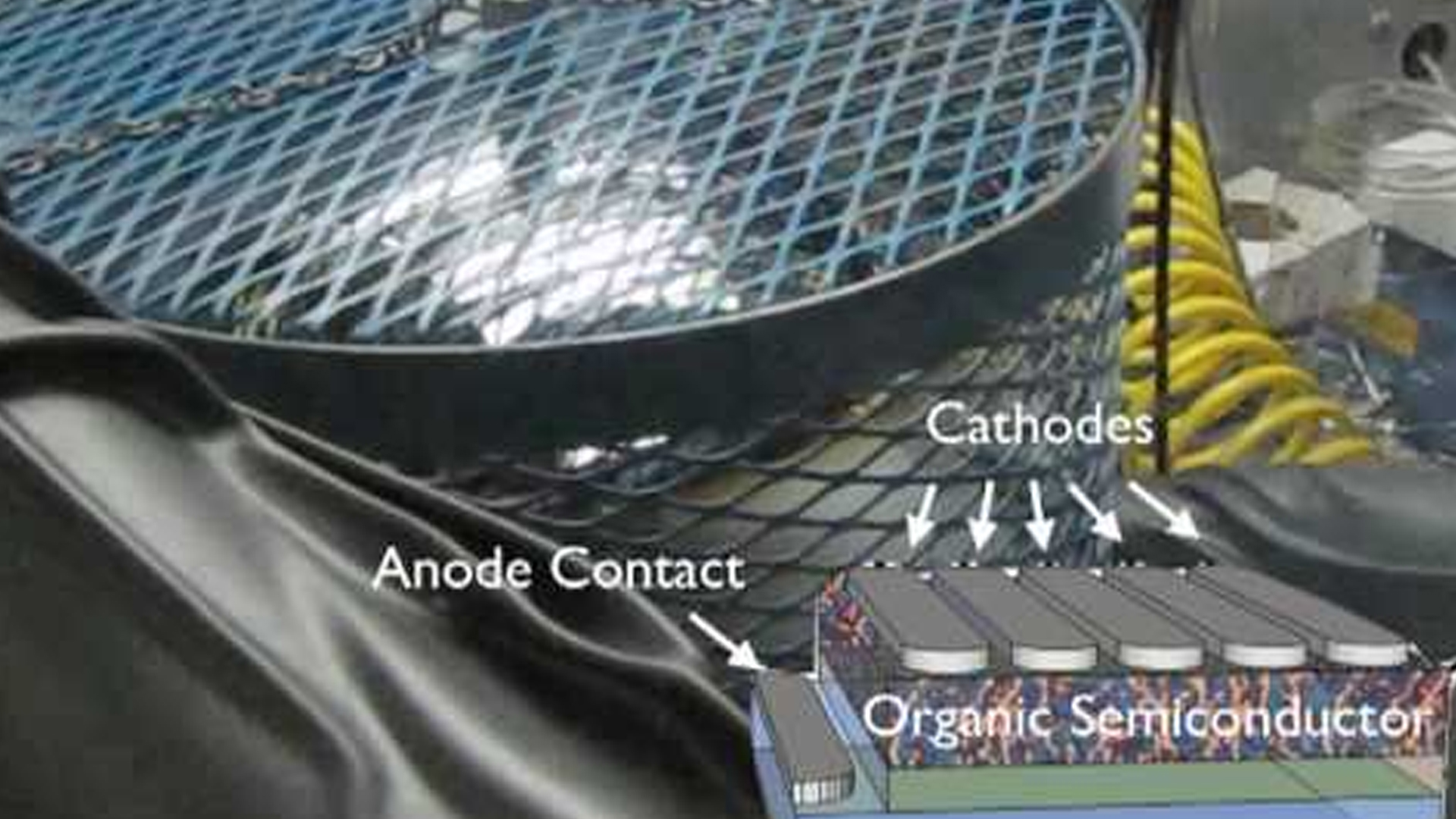SuperSolar Hub brings UK researchers together to focus on perovskite PV
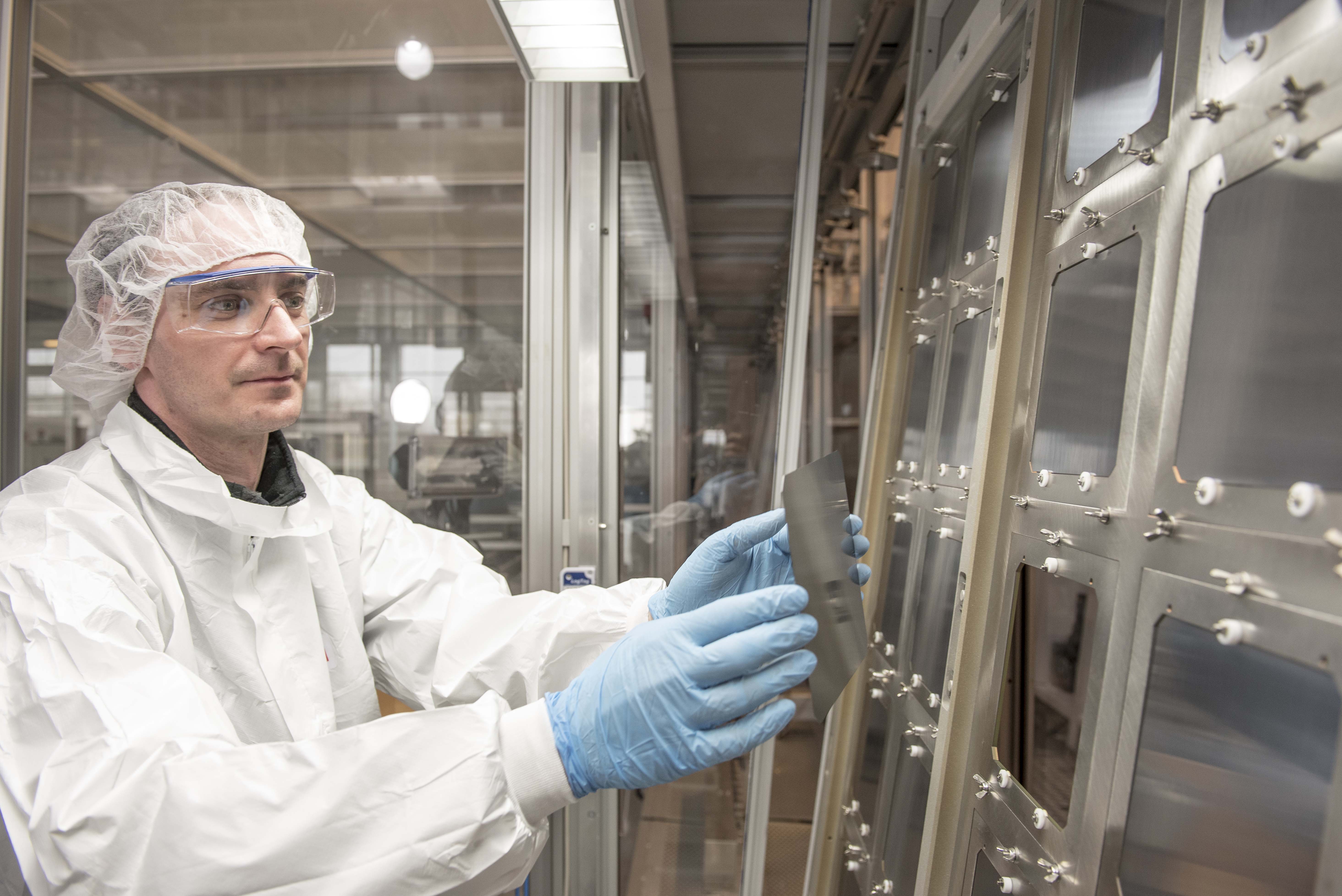
The commencement of the SuperSolar Hub in May 2012, as part of the Engineering and Physical Sciences Research Council (EPSRC) SUPERGEN programme, coincided with the publication of game-changing developments in perovskite technologies from one of the core+3 SuperSolar Hub members, Prof Henry Snaith at Oxford University, who was quickly recognised amongst Nature’s Ten People Who Mattered This Year in 2013. Since then the Hub has been the focal point for UK research in perovskite PV.
Picture credit Oxford PV : Commercial sized perovskite-on-silicon solar cells in production at Oxford PV’s pilot line in Germany.
The SuperSolar Hub is led by Loughborough University, and comprises the Universities of Bath, Cambridge, Imperial College London, Liverpool, Oxford, Sheffield, Southampton, Swansea and Warwick. The SuperSolar Hub has provided an ideal forum for UK researchers to connect with these developments and work together to address key challenges in perovskite PV. Hub director Prof Mike Walls says, “The SuperSolar Hub partners are a complementary mix of researchers within the PV field in the UK, with internationally recognised expertise in areas ranging from the formulation and fundamental characterisation of perovskite materials, to the development of cell materials and architectures that capitalise on their properties. By working together, the SuperSolar Hub has been able to mobilise quickly its available resources to target perovskites as exciting Third Generation PV materials”.
Leading on perovskite PV
The outstanding achievement to come from the SuperSolar Hub partners has been the dramatic improvements in cell efficiency achieved with solid state perovskite-based solar cells at Oxford by Prof Henry Snaith and his team. Snaith first considered the potential of perovskite materials as a solar light absorbing component in dye sensitised solar cells (DSSC) after seeing their relative ease of synthesis, embarking on what was to prove a fruitful collaboration with their originator Miyasaka, and Murakami at Toin University in Japan.
The creation of large polycrystalline grains, partially replacing iodine within the ABX3 perovskite structure (A = organic cation, B = metal, typically Pb and X = halide anion), and replacing the mesoporous TiO2 conductor layer with non-conducting Al2O3 all proved pivotal, offering greater perovskite stability, better charge carrier transport and much higher open-circuit voltage. These developments took the cell efficiency from low single figures to over 10% and demonstrated that perovskite materials showed great potential and not simply as a dye replacement in DSCC. The resulting publication in Science and subsequent demonstration of thin-film device configurations drew phenomenal interest and global research efforts and competition quickly accelerated.
Since then, the pace of development has been astonishing. Mixed cation perovskite formulations have increased stability dramatically such that module longevity concerns have now largely dispersed. Changes in the hole transport material have further enhanced that stability such that industry standard IEC equivalent tests have been passed with tandem cells. Tandem cells have perovskite coated directly onto a silicon cell to produce a two-junction cell taking the energy produced beyond the record efficiency for silicon cells, and potentially into areas beyond 30%, bringing commercial uptake closer and closer.
However, Snaith highlights that there is still a pressing need for greater understanding and more fundamental research focussing on factors such as reliability and standardisation of device characterisation, environmental impact management, the hysteresis and stability of the cells, and pathways to even more efficient charge transfer. Snaith says, “In order to capture the true potential for perovskite PV, and to remain globally competitive with amassing international efforts, coordinated UK research activity is essential”.
SUPERGEN – support for energy research from UK Government
The EPSRC SUPERGEN programme represents the UK Government’s biggest investment in low-carbon energy, with the vision to promote sustainable power generation and supply, inform energy policy and bring together the required innovation infrastructure to meet fundamental challenges identified by researchers. Since the inception of the programme in 2001, renewable energy technologies, most notably wind and solar PV, are now being deployed at a huge scale, and power generation costs have fallen to the point where they are competitive with conventional fossil fuel sources.
The SUPERGEN Programme, now in its third phase, operates a ‘hub and spoke’ model where the hub acts as a focus for all major EPSRC funded activity within a research area. The hubs allocate flexible funding against specific challenges and operates the peer-review for this flexible funding independently of EPSRC. This approach has allowed the individual SUPERGEN hubs to adapt to changing research needs. The emergence of perovskite PV and the SuperSolar Hub’s response to it has been perhaps the best example of this response model in action.
SuperSolar Hub - collaborating to realise the potential of perovskite technologies
Since its inception, the SuperSolar Hub has witnessed significant changes in the policy landscape in the UK. Deployment of PV throughout the UK gathered pace, promoted by generous feed-in tariffs, which saw significant uptake by both domestic and utility-scale producers. While government investment has now scaled-back, other drivers such as the generation balance between traditional and low-carbon sources has firmly established solar PV as a core element in the UK power supply mix. The balance is poised to shift further, with the explosion of activity surrounding perovskite PV.
The SuperSolar Hub recognised the importance of perovskite development very early and used its flexible funding to mobilise complementary research across the Hub. The links already forged between the key UK researchers as part of the SuperSolar Hub allowed them to focus resources towards perovskite PV. As part of the EPSRC funding model, the SuperSolar Hub was allocated a significant flexible funding pot that could be strategically distributed and took the decision to direct most of this allocation towards perovskite PV during its first flexible funding call in early 2014. Both SuperSolar Hub core institutions and hub members from the wider research community were invited to submit plans for research. These efforts were enabled by a further injection of funding from EPSRC in 2015 to support a programme of focussed research managed by the SuperSolar Hub.
This initiative stimulated the UK research effort in a concerted fashion, allowing researchers to mobilise quickly without the usual lead time (12 months or more) of EPSRC standard responsive mode applications for funding. The SuperSolar Hub quickly decided on suitable projects, and work was able to commence within 3 months of the call.
The scientific highlights from this initiative are:
Oxford University has focused on developing more stable and efficient perovskite solar cells and key breakthroughs have been made; the realisation of much more stable compositions which include an A-cation alloy of formamidinium and caesium; fabrication of efficient wide band gap perovskite absorbers suitable for tandem solar cell integration; very efficient perovskite-on-silicon tandem solar cells resulting in a >20% boost in energy output; and proof of concept of all-perovskite thin-film multi-junction cells. Much of the work was carried out with support from other SuperSolar Hub members.
Bath University developed modelling concepts to further understand the structure and dynamics of mixed cation compositions. Insights into crystal vibrations, molecular rotations and electron transport have resulted and models for hysteresis effects in perovskites have been proposed.
Cambridge University has expanded the application of perovskite semiconductors into light-emission, setting new efficiency records for perovskite LEDs. New methods have also been developed to improve the optical out-coupling of perovskite LEDs by incorporating scattering centres.
Imperial College London has developed new non-fullerine acceptor materials leading to device efficiencies beyond 13% with improved stability and have proposed detailed mechanisms for perovskite degradation.
Loughborough University has tailored broad-band anti-reflection coatings for the required bandgaps for perovskite-on-silicon tandem cells and developed an efficient indium zinc oxide transparent conductor with infra-red transmission between the perovskite-on-silicon tandem cells.
Sheffield University has progressed the understanding of perovskite structure, mapping individual perovskite grains to monitor grain size evolution, distribution and rotation to build a picture of grain dynamics. In addition, Sheffield has succeeded in spray-coating complete perovskite PV devices with an efficiency of 17.8%.
Southampton University has developed passivated black silicon for use as front surface anti-reflection in the tandem module and are working on hybrid perovskite-CdTe nanoparticle thin films.
In addition, University of Liverpool has explored the properties of the planar-heterojunction between the perovskite and charge extraction layers, Swansea University has addressed the scale up challenges for flexible perovskite solar cells, Edinburgh University has developed lower cost alternatives to the typically employed organic hole-conductor Spiro-OMETAD, and University College London has investigated formulations for new hybrid perovskite materials.
Promoting collaboration between and beyond the SuperSolar Hub
SuperSolar Hub researchers have been able to further capitalise on the rapid response to perovskites by sharing outcomes with the wider PV community in the UK during the annual SuperSolar Hub technical meetings. These new perspectives quickly led to more ambitious proposals for research funding that have brought together SuperSolar Hub partners, both with other research institutions and industry, to justify further funding from EPSRC.
The recently funded EPSRC Prosperity Partnership between Oxford University and Oxford PV Ltd illustrates the rapid progress made in perovskite sector maturity in the UK, such that EPSRC are anticipating that industry will become more involved in funding activities as TRL levels rise. Snaith says, “It is most likely that the first high volume manufactured product to market will be a perovskite-on-silicon tandem cell, with a production cell efficiency at around the 27% mark. Ultimately, the perovskite-on-silicon tandem cell could reach efficiencies into the 30 to 35% range, and moving towards triple junction cells, could approach and even surpass 40% efficiency. In order to achieve this however, much effort is required to significantly improve the efficiency of perovskite solar cells with different band gaps, and also to ensure that all the materials needed for the multi-junction device stacks are stable. Beyond silicon wafer based multi-junction cells, there are also significant opportunities for thin-film perovskite PV on glass, and other flexible substrates. All these activities beyond the first product, require low TRL research, well aligned with EPSRC’s funding strategy“.
The near future: bringing perovskite cells to market
The SuperSolar Hub partners have a strong history of successfully collaborating with industry. Oxford PV was co-founded by Henry Snaith in 2010 and has exclusive access to the fundamental perovskite IP from Snaith’s Oxford University lab. The company is poised to commercialise its perovskite-on-silicon tandem solar cell technology. Having acquired a pilot production facility near Berlin, the company is producing commercial sized tandem cells for validation by its development partner, a global silicon solar cell and module manufacturer. The first modules from the pilot line are expected to be deployed in the field this year.
Oxford PV’s perovskite-on-silicon tandem solar cell technology continues to extend the world record for cell efficiency (currently 28% at time of going to press but expected to reach beyond 30% in the near term). Importantly for reaching the marketplace, stability has been demonstrated for thousands of hours, surpassing the same IEC test criteria required for traditional silicon cells.
Dr Chris Case, Chief Technology Officer at Oxford PV says, “The SUPERGEN programme has brought together a number of researchers from diverse communities that have allowed access to a broad portfolio of expertise. We can specifically say that the SuperSolar Hub has helped Oxford PV, especially to externally validate the performance of our solar cells”.
Continuing support for UK research from the SuperSolar Hub
The SuperSolar Hub reaches around 700 individual members drawn from over 50 institutions. Core and Associate partners come together annually to share the latest developments in PV research, providing a forum for early career researchers to build experience and contacts with both other academics and industry. Whilst the current round of EPSRC funded activity does not include provision for the Hub to allocate further targeted research funding, it can offer support through other mechanisms:
International & Industrial Engagement Fund: enables UK researchers to undertake secondments with international or industrial partners, accessing facilities and skills.
International Conference Fund: enables UK students and researchers to present findings at international conference events.
Secondments Fund: enables UK students and researchers to make short visits to specialist laboratories.
By encouraging early stage researchers in the PV field to realise the ambition of their research ideas, the SuperSolar Hub seeks to enable similar seismic shifts in the research landscape as it has already witnessed with the evolution of perovskite PV.


